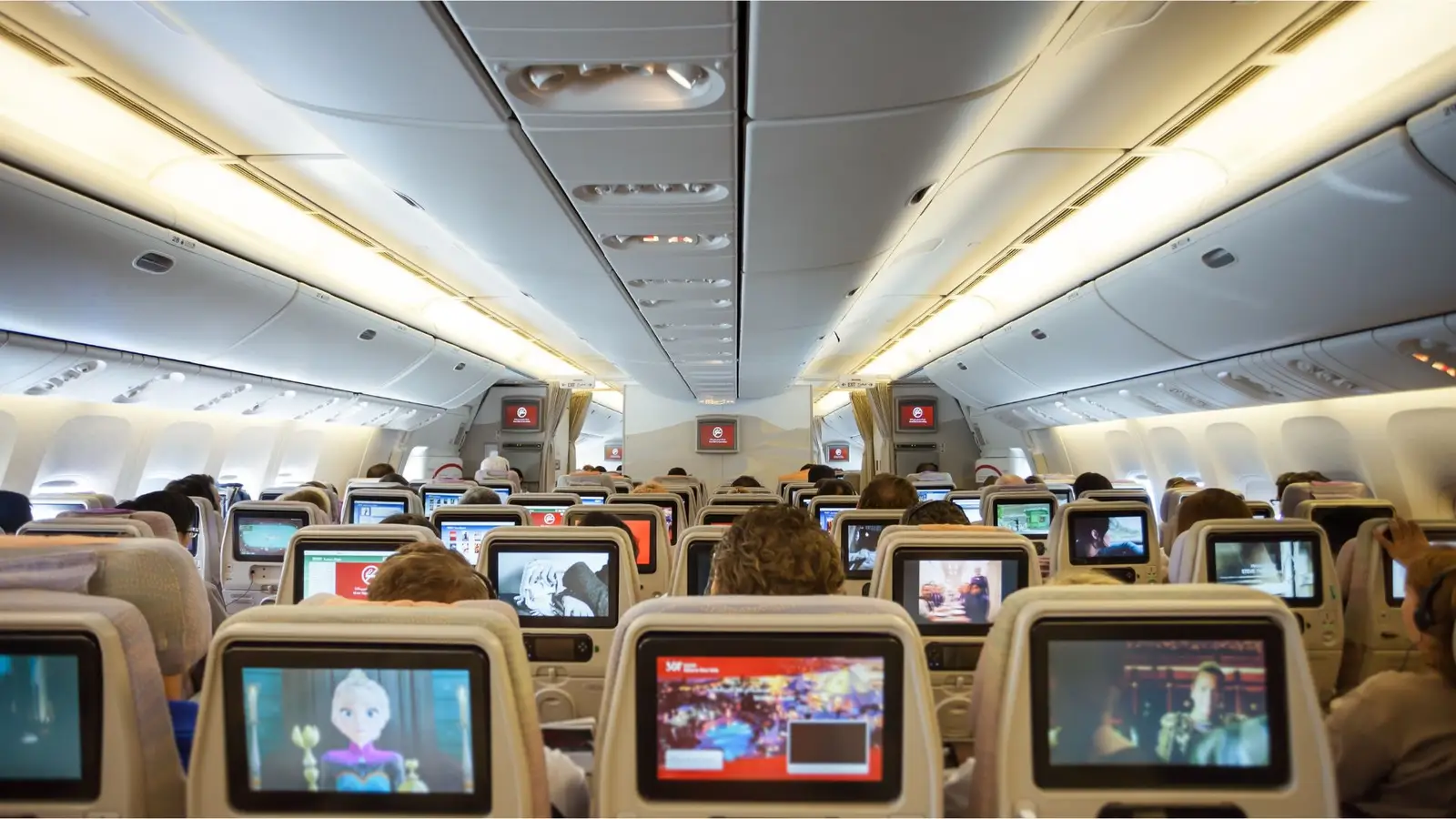
Nowadays, it seems that airlines are increasingly removing seatback screens and inflight entertainment, especially on short-haul and medium-haul routes. This is for a number of reasons, including costs and changing passenger habits. Let’s find out why this is becoming more prevalent in the airline world.
Inflight entertainment(IFE) was first introduced to commercial aviation in 1921, when Aeromarine Airways showed an in-flight movie promoting the city of Chicago, according to OAG. However, this did not truly become an everyday feature of airlines until 1961, when Trans World Airlines (TWA) introduced in flight entertainment. Back then, it was a nicety, not a necessity. The IFE systems we know today were first established in the late 1980s, when LCD TVs were fitted into seatbacks.
How Did IFE Fall Out Of Favor?
American Airlines decided to remove seatback screens on its Airbus A319 fleet in recent years in a bid to save costs and said that it made no sense to have the screens on short-haul or medium-haul flights. This made the aircraft lighter with thousands of pounds of weight removed, resulting in lower operating costs and ultimately saving fuel. They encouraged passengers to use their personal devices to access entertainment via WiFi for free, on their narrow-bodied jets.
The seatback screens were replaced by device holders, power outlets, USB ports and fast WiFi. Of course, this move saves on maintenance and installation costs, with the installation of seatback screens costing around $10,000 per seat, according to Tec Sci Research. This is a considerable expense and the system still has to be maintained and updated at high cost. Therefore, removing the screens saves an airline millions of dollars per aircraft, which does seem a wise move. The removal of the screens also reduces the aircraft’s weight considerably, which results in better fuel efficiency.
American also noted that many passengers preferred to stream or upload content on their own personal devices (laptops, smartphones and tablets) and were using them instead of the seatback screen. Furthermore, American Airlines will remove seatback entertainment from its new Boeing fleet under its Oasis project. In doing so, they are catering to 90% of their passengers who carry their personal devices whilst traveling, according to data from OAG.
How Did Other Airlines Respond To This Decision?
In the meantime, Delta Air Lines kept their seat back screens and continue to upgrade their inflight entertainment systems and show no sign of following suit. They offer both IFE and streaming services and believe that seatback entertainment still has value and is an important part of the inflight experience. JetBlue continues to provide seatback entertainment for its passengers and also offers a streaming service with Peacock.
United Airlines and American have been phasing out the screens on their new short-haul aircraft, instead offering content that passengers can stream to their personal devices. However, United Airlines is now installing new OLED seatback monitors across its fleet under the ‘United Next’ initiative. Hawaiian Airlines has also phased out seatback entertainment on its Airbus A321neo.
American is one of the largest and most popular airlines in the world, and made a bold decision to remove seatback entertainment screens from many of its aircraft. It was a bold move and seen as somewhat controversial, but some other US airlines noted and followed the same route. They cited that cost efficiency, improving aircraft performance and changing passenger trends were the reasons for the decision.
The Advantages Of Removing Screens
The move to drop seatback screens also helps reduce the weight of seats and allows for more legroom. IFE systems require complex wiring, servers, and power systems, so removing them saves more and allows for more cabin space. Sometimes, noise and lack of privacy can be an issue for passengers, as well as using outdated systems and the movement of the seat, when passengers seated behind press forward on the screen. The airlines also have to pay fees for content and licensing every few months to keep content updated and relatable.
Of course, IFE systems often have technical issues or malfunctions, and these are costly not only to repair, but also in terms of flight delays and customer satisfaction. By removing the systems, disruptions caused by IFE technical issues are avoided, less maintenance is required, and fewer complaints are made about the IFE not functioning correctly. Airlines are being encouraged to improve WiFi, instead of relying on screens. Safran has introduced new technology, named ‘RAVE’, that enables passengers to stream content from a device to a seatback screen.
Airlines have to be environmentally aware and be sustainable, so reducing IFE systems has become somewhat of a priority. They are under pressure to reduce their carbon footprint and minimize their environmental impact. As well as reducing the weight of the aircraft and making it more fuel efficient, emissions are reduced. Therefore, the move to remove seatback screens makes air travel more eco-friendly and aligns with the airlines’ sustainability goals.
The BYOD Trend
The trend of BYOD (Bring Your Own Devices) has been determined as a major reason to remove seatback screens. Passengers often have one or more devices, including laptops, tablets, or smartphones, when traveling and use those for their entertainment needs, making IFE systems redundant. These have the latest high-quality screens, rendering traditional IFE systems to become quickly outdated as they are used for many years and are expensive to replace.
Passengers can have access to their favorite online services, social media, and personal communication systems during a flight. This trend has picked up further, with airlines introducing WiFi and facilities to charge devices in seat. Airlines can also market WiFi as a premium service for additional revenue.
According to a study by Tech Sci Research:
46% of passengers had watched a movie on a device during a flight
44% of passengers had used seatback screens and IFE systems
10% of passengers switched between a personal device and the IFE
65% would use their device for the purpose of watching IFE or streaming
92% said that they enjoyed the experience
The removal of seatback screens at American started in 2017 and has been underway for over a decade. This was at the same time that the airline introduced its Boeing 737 MAX fleet, which did not have seatback screens fitted. It is thought that this fueled the BYOD method of entertainment.
The Case For Keeping Seatback Entertainment
Although more passengers are using their personal devices for inflight entertainment, there is also an argument for keeping IFE systems and screens, as they have long been considered part of the flight experience. It was found that removing the screens in business class, may be a drawback as passengers seated there tend to juggle working on a device with watching a movie or listening to music through the IFE at the same time. Productivity plus entertainment is important in premium cabins.
Despite the fact that some airlines have decided to remove IFE onboard, other airlines have upgraded it. There is no doubt that high-quality screens, a wide variety of content, and noise-canceling headphones all make for a premium experience. This could also enhance the passenger’s perception of the airline and their loyalty.
Seatback screens are used for airline branding and offer personalized options for passengers, which are advantageous. As with personal devices, there is no doubt that screens and technical innovations continue to improve every day, which may lead to lighter and more energy-efficient seatback screens.
Will Airlines Finally Ditch Inflight Entertainment Systems?
Currently, IFE offers WiFi connectivity and streaming services, enabling a wide range of entertainment at passengers’ fingertips. High-speed satellite WiFi has changed things considerably, as passengers can stream content to their own personal devices instead of relying on airline IFE and seatback screens. This aligns with the BYOD trend, and some airlines are encouraging this by removing seatback screens on some aircraft, which in turn reduces costs. The secondary effect is that it is eco-friendly as there is less fuel burn and emissions, and it helps the airlines to be more sustainable.
Although there is a definite trend of removing seatback screens and IFE systems in the short-haul and medium-haul markets, this trend does not continue into the long-haul market. In fact, some airlines are investing in new high-quality seatback screens to improve the passenger experience. IFE is a definite distraction for passengers, especially for flights of over five hours, so it will not be going away at most international airlines.
All in all, the airlines have to find a balance between cost, weight, and customer satisfaction that will determine the future of seatback entertainment. Moving forward, it is likely that airlines will adopt to a hybrid model as some are now doing, with both traditional IFE systems and new streaming services to personal devices on offer.



